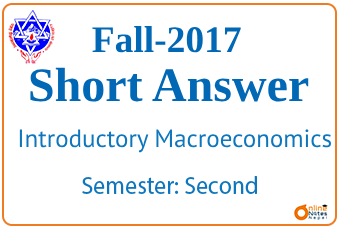Published by: Dikshya
Published date: 08 Sep 2023

1. What is the scope of Macroeconomics?
- The scope of macroeconomics includes analyzing and understanding the determinants of these key macroeconomic variables, formulating economic policies to achieve macroeconomic goals, and studying the interactions between different sectors of the economy.
2. What is the essence of Say’s Law of Market?
- Say's Law, proposed by Jean-Baptiste Say, states that "supply creates its own demand."
3. Find out the value of the GDP deflator when real GDP is 117.43 million and nominal GDP is 111.37 million.
- The GDP deflator is calculated using the following formula: GDP Deflator = (Nominal GDP / Real GDP) * 100 Given:
4. Suppose C= 100+o.5Y, I= Rs. 200, G=400. Find the value of the investment multiplier.
- The investment multiplier is calculated using the following formula: Investment Multiplier = 1 / (1 - Marginal Propensity to Consume)
MPC = dC/dY = 0.5,
Investment Multiplier = 1 / (1 - MPC) = 1 / (1 - 0.5)= 1 / 0.5= 2
therefore, investment multiplier is 2.
5. Distinguish between Average and marginal propensity to consume.
- Average Propensity to Consume (APC) is the ratio of total consumption expenditure to total income. It represents the proportion of income that people typically spend on consumption.
- Marginal Propensity to Consume (MPC) is the change in consumption resulting from a one-unit change in income. It represents the additional consumption that occurs when income increases by a small amount.
6. What are the determinants of investment?
- The determinants of investment include:
Interest rates, Business expectations, government Policies, Economic Conditions and technological advancements.
7. Define the term budget deficit.
- A budget deficit occurs when a government's expenditures exceed its revenues within a specific time period (usually a fiscal year)
8. State the relationship between unemployment and rate of inflation according to Philips.
- The Phillips Curve shows an inverse relationship between the rate of inflation and the rate of unemployment. According to the Phillips Curve, as inflation increases, unemployment decreases, and vice versa
9. What are the major features of the depression phase of the trade cycle?
- Features of the Depression Phase of the Trade Cycle:
10. Point out instruments of monetary policy.
- Common instruments of monetary policy include:
Open Market Operations, Discount Rate, Reserve Requirements and Forward Guidance